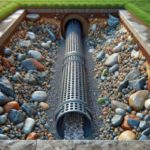Prioritising Water Safety: The Crucial Role of Backflow Testing in Langley
What Exactly is Backflow and Why is Regular Testing Crucial for Water Safety?

Backflow is a serious concern that arises when water flow reverses unexpectedly, leading to the potential influx of harmful contaminants into the clean water supply. This hazardous situation can significantly endanger public health, contributing to the transmission of waterborne diseases. Hence, the implementation of regular <a href="https://limitsofstrategy.com/backflow-testing-services-safety-assurance-in-whistler/">backflow testing</a> is imperative for preserving water quality and safeguarding the health and safety of the entire community. By systematically detecting potential backflow issues, timely corrective measures can be executed to avert contamination, thus ensuring that all residents have uninterrupted access to clean drinking water.
The primary causes of backflow often encompass a variety of factors, including:
- Pressure drops within the municipal water supply system that create vulnerabilities
- Improperly installed plumbing systems, which can lead to significant risks
- Backpressure caused by irrigation systems or specific equipment
- Connections that link contaminated sources to potable water systems
- Faulty backflow prevention devices that fail to operate as intended
- Cross-connections between drinking water and non-potable water systems
- Environmental factors such as flooding that disrupt normal water flow
- Changes in local water consumption patterns that can affect pressure dynamics
Establishing robust backflow testing protocols is essential for identifying and resolving these critical issues before they jeopardise public health and safety.
What Regulations Govern Backflow Testing Practices in Langley?
In Canada, comprehensive regulations mandate the necessity for routine backflow testing to uphold safety standards across all municipalities. In Langley, these regulations are stringently enforced to prioritise public health and mitigate the risk of penalties for non-compliance. Facilities must strictly adhere to local bylaws that specify testing frequency and standards. The Canadian Standards Association (CSA) provides essential guidelines that local authorities implement to ensure the safety and purity of the water supply for all residents.
Exploring the Numerous Benefits of Consistent Backflow Testing for Your Facility
Engaging in regular backflow testing yields an array of advantages that extend well beyond mere regulatory compliance. It serves as a fundamental component in ensuring the safety of drinking water by effectively curtailing contamination risks, which is vital for public health. The early identification of backflow issues allows for prompt repairs and interventions, potentially saving substantial costs related to major water quality failures. Moreover, consistent testing plays a crucial role in sustaining the integrity of the entire water system, guaranteeing that the community receives reliable and safe water services without interruptions.
Professional Insights on Backflow Testing Services Available in Langley

How Frequently Should You Arrange Backflow Testing?
The frequency with which backflow testing should be conducted is primarily determined by the type of facility and the specific local regulations governing Langley. Generally, most commercial properties are mandated to undergo testing on an annual basis; however, high-risk areas or facilities with intricate plumbing systems may require more frequent evaluations, such as biannual or even quarterly assessments. For instance, establishments like restaurants, hospitals, and industrial sites often face stricter testing requirements due to the elevated risks associated with potential backflow incidents. Remaining vigilant about local regulations and adapting to shifts in water usage patterns is crucial for maintaining compliance and ensuring public health.
What Key Factors Should You Consider When Selecting a Backflow Testing Service Provider?
Choosing the right backflow testing service provider is vital for ensuring accurate and trustworthy testing outcomes. Seek a provider that possesses the necessary certifications, extensive experience, and a deep understanding of local regulations. It is essential that they offer comprehensive testing services that include timely reporting of results and actionable follow-up recommendations. Verify that their team is well-trained and knowledgeable about Canadian standards and practices related to backflow prevention. A reputable provider should also have a demonstrated history of successful testing and satisfied clients, showcasing their expertise and reliability in the field of backflow management.
Highlighting Successful Case Studies in Backflow Prevention

Examining real-world instances of effective backflow prevention highlights the essential need for regular testing. For example, a local hospital in Langley identified a significant backflow issue during routine testing that could have jeopardised the quality of their drinking water. By promptly addressing the problem, they safeguarded the health and safety of both their patients and staff. Detailed case studies like this serve to illustrate how effective backflow testing can avert severe public health crises, underscoring the necessity of regular testing to protect community water supplies from contamination.
Why is Ongoing Backflow Testing Indispensable for Langley?
Regular backflow testing is essential for ensuring the safety and quality of Langley's water supply. By diligently preventing contamination through rigorous testing, facilities not only comply with local regulations but also protect public health. The community substantially benefits from continuous monitoring of water quality, and establishments that prioritise testing clearly demonstrate their commitment to safety and compliance. Establishing a routine testing schedule is not merely a regulatory obligation; it is a critical measure in safeguarding the entire water system against potential hazards and ensuring ongoing access to safe drinking water for residents.
Understanding the Backflow Testing Procedures
What Are the Fundamental Steps Involved in Backflow Testing?
The backflow testing process comprises several critical steps designed to guarantee the effective operation of backflow prevention devices. Initially, a certified professional inspects the device for any visible signs of wear or damage that may compromise its functionality. Following this inspection, pressure tests are conducted to evaluate whether the device operates correctly under various conditions. Throughout the testing procedure, results are meticulously documented, providing insights into the device’s performance and any necessary repairs. Upon completing the testing, a comprehensive report is generated that details all findings, recommendations, and any actions required to ensure compliance and optimal functionality.
What Specific Tools Are Utilised in Backflow Testing Procedures?
Utilising specialised equipment is vital for conducting accurate backflow testing. Professionals depend on test kits specifically engineered for evaluating backflow prevention devices, alongside pressure gauges that measure fluctuations in water pressure. These tools ensure that the testing process is thorough and credible, yielding reliable results that can be acted upon. Furthermore, employing calibrated devices guarantees that the testing meets or surpasses industry standards, making the data collected both precise and actionable for any necessary maintenance or repairs.
Who is Qualified to Perform Backflow Testing in Langley?
In Langley, only certified professionals who have undergone specialised training in backflow prevention are authorised to conduct testing services. These experts must comply with both local regulations and Canadian standards, ensuring that the testing process is carried out accurately and safely. Engaging providers who possess the relevant certifications and extensive experience guarantees that testing is done effectively, thereby protecting both the facility and the community from potential health hazards associated with backflow issues.
Research-Backed Benefits of Backflow Testing Services in Langley
What Long-Term Advantages Can Be Gained from Regular Backflow Testing?
The long-term benefits of consistent backflow testing are substantial. By ensuring that the water supply remains uncontaminated, facilities can uphold high standards of water quality over time. This proactive measure helps avert potentially costly repairs that could arise from contamination incidents. Additionally, regular testing promotes compliance with health regulations, potentially shielding facilities from legal repercussions and financial penalties. Ultimately, the protection of public health through reliable water supply management is the most significant outcome of consistent backflow testing practices.
How Does Regular Backflow Testing Influence Property Value?
Properties that prioritise regular backflow testing are increasingly appealing to both buyers and tenants, primarily due to the assurance of safe drinking water. Buyers are placing greater emphasis on properties that demonstrate a strong commitment to health and safety standards, which include routine testing for backflow. This proactive approach can enhance a property’s marketability and overall value, signalling well-maintained infrastructure. In Langley’s competitive real estate market, showcasing a commitment to water safety through ongoing testing can serve as a vital differentiator in attracting potential buyers or tenants.
Practical Steps for Establishing a Robust Backflow Testing Programme
Establishing an effective backflow testing programme involves several actionable steps. Begin by assessing the specific needs of your facility while familiarising yourself with local testing regulations. Next, select a certified provider with a solid reputation in backflow testing services. Schedule regular testing dates—ideally annually, although more frequent checks may be necessary for higher-risk facilities. Ensure that you maintain comprehensive records of all testing and compliance documentation to demonstrate adherence to regulations. Finally, stay informed about any changes in local laws that may impact your testing requirements, ensuring that your programme remains compliant and effective.
How Can Routine Backflow Testing Help Mitigate Health Risks?
Consistent backflow testing is vital for minimising health risks associated with contaminated water supplies. By promptly identifying and addressing backflow issues, the likelihood of waterborne diseases is significantly reduced. Regular testing guarantees that the community has access to safe drinking water, thereby preserving public health. Establishing a routine testing programme empowers facilities to uphold their commitment to safety and compliance, ultimately fostering a healthier environment for all individuals within the community.
What Environmental Benefits Are Associated with Regular Backflow Testing?
The environmental implications of routine backflow testing are considerable. By preventing cross-connections that could lead to chemical or pollutant spills into water systems, testing fosters ecological health and sustainability. Implementing proper backflow prevention measures helps protect local ecosystems and wildlife that depend on clean water sources. Furthermore, maintaining clean water supplies reduces the necessity for costly environmental remediation efforts in the future, benefiting both the local community and the broader environment.
Implementing Effective Strategies for Backflow Testing Services in Langley
What Best Practices Should Be Employed for Effective Backflow Prevention?
Implementing effective best practices for backflow prevention is essential for maintaining safe water systems. Establish regular testing schedules to ensure that all backflow prevention devices are monitored and maintained appropriately. Engage certified professionals for testing and repairs to guarantee compliance with local regulations. Additionally, maintain detailed records of all testing and maintenance activities, which can provide valuable insights for future assessments. Proper installation of backflow devices significantly minimises the risk of backflow incidents, reinforcing the necessity of adhering to best practices in safety and compliance.
How to Select the Appropriate Backflow Prevention Device for Your Facility?
Choosing the right backflow prevention device necessitates careful consideration of your facility's specific requirements. Factors such as flow rate, water pressure, and the level of hazard posed by potential contaminants should guide your decision-making process. Consulting with experienced professionals can yield tailored recommendations that comply with local regulations and enhance protection against backflow. A thorough understanding of your facility’s unique needs is essential for selecting a device that delivers both safety and high performance.
How to Provide Expert Analysis on Backflow Testing Results?
After completing backflow testing, delivering an expert analysis of the results is paramount for informed decision-making. This includes a detailed interpretation of the test outcomes, highlighting any necessary maintenance, repairs, or replacements. Clear recommendations based on findings empower facility managers to take prompt action, ensuring that any issues are addressed before escalating into larger problems. Regular communication and follow-up services strengthen the relationship between service providers and clients, fostering trust and accountability in maintaining water safety.
What Steps Are Required to Ensure Compliance with Local Backflow Regulations in Langley?
To ensure compliance with local backflow regulations in Langley, it is vital to stay informed about current bylaws and requirements. Regularly schedule testing and certification as mandated by local authorities while maintaining comprehensive documentation of all compliance activities. Collaborating with certified professionals who possess knowledge of local laws can facilitate efficient navigation through compliance requirements. This proactive approach not only helps avoid potential fines but also reinforces a commitment to public health and safety within the community.
Understanding the Costs and Scheduling of Backflow Testing in Langley
What Factors Influence the Cost of Backflow Testing Services?
Several key factors affect the cost of backflow testing, including the size and complexity of the facility, the type of backflow prevention devices in operation, and the required frequency of testing. Larger facilities with intricate plumbing systems typically incur higher costs due to the additional time and resources needed for comprehensive testing. Furthermore, labour and equipment costs can fluctuate based on local market conditions and the specific service provider chosen. Understanding these variables can assist facilities in budgeting effectively for necessary testing and maintenance while ensuring compliance with regulations.
How to Efficiently Schedule Backflow Testing Services?
Scheduling backflow testing services begins by identifying certified providers within your area. Reach out to discuss your specific needs and establish the required frequency of testing based on local regulations. Planning ahead is essential to ensure compliance while avoiding disruptions to your water supply. Many providers offer flexible scheduling options, allowing facilities to choose dates that minimise operational impacts. Establishing a consistent testing schedule is key to maintaining reliable water quality and safety for all users in the community.
What Should Be Known About the Reporting and Documentation Process for Backflow Testing?
Following the completion of backflow testing, a detailed report is generated that outlines the test results and any observed issues. This documentation is critical for compliance purposes, serving as evidence that the facility has adhered to local regulations. Proper reporting should encompass recommendations for maintenance or repairs if necessary. Keeping thorough records is beneficial for facility managers, assisting them in tracking testing history and identifying emerging trends that may require further attention. This proactive strategy supports ongoing water safety and compliance efforts within the community.
Common Questions Regarding Backflow Testing Services
What is the primary purpose of backflow testing?
The primary aim of backflow testing is to verify whether backflow prevention devices are functioning correctly, thereby preventing contaminants from infiltrating the clean water supply and preserving public health.
How often should I schedule backflow testing?
Typically, backflow testing should occur annually, but certain facilities may require more frequent testing based on local regulations or unique risks associated with their operations to ensure safety and compliance.
Who is qualified to conduct backflow testing in Langley?
Only certified professionals trained in backflow prevention and testing are authorised to provide these services in Langley, ensuring adherence to local regulations and safety standards throughout the testing process.
What are the potential consequences of neglecting backflow testing?
Neglecting regular backflow testing can lead to the contamination of the drinking water supply, resulting in significant health hazards and potential penalties from regulatory bodies, ultimately threatening community well-being.
How can I find a certified backflow testing provider?
You can locate certified backflow testing providers by searching online directories, consulting local health authorities, or seeking recommendations from other facility managers in your area who have experience with testing services.
What can I expect during a backflow test?
During a backflow test, the technician will inspect the backflow prevention device, conduct pressure tests, and subsequently document the results in a comprehensive report, ensuring transparency and accountability.
Can backflow testing result in cost savings for my facility?
Yes, regular backflow testing can prevent costly repairs stemming from contamination incidents and protect your facility from fines related to non-compliance with regulations, thereby saving money in the long run.
Are there different types of backflow prevention devices available?
Indeed, various types of backflow prevention devices exist, including air gaps, reduced pressure zone devices, and double check valves, each suited for different applications and specific needs within facilities.
How does backflow testing contribute to the protection of public health?
Backflow testing ensures that contaminants do not infiltrate the drinking water supply, effectively protecting public health from the risks of waterborne diseases and other health threats associated with contaminated sources.
What documentation is required following backflow testing?
After testing, a detailed report is necessary that documents the results, any required repairs, and compliance with local regulations for future reference and accountability, ensuring transparency and safety.
Connect with us on Facebook for more updates!
The Article: Backflow Testing Services in Langley: Ensuring Water Safety First Published On: https://pacificbluemechanical.ca/
The Article Backflow Testing Services: Safeguarding Water in Langley Was Found On https://limitsofstrategy.com

